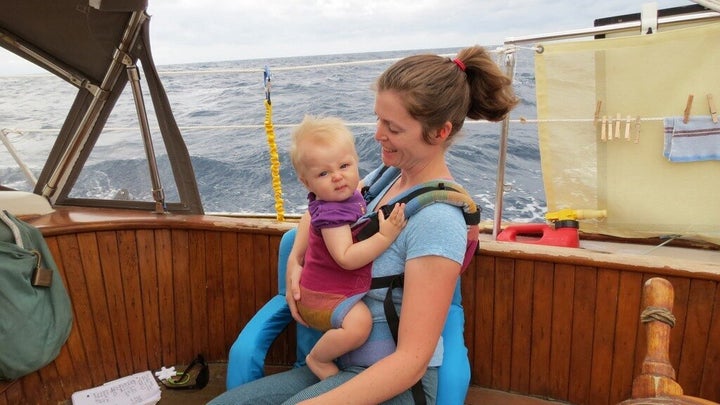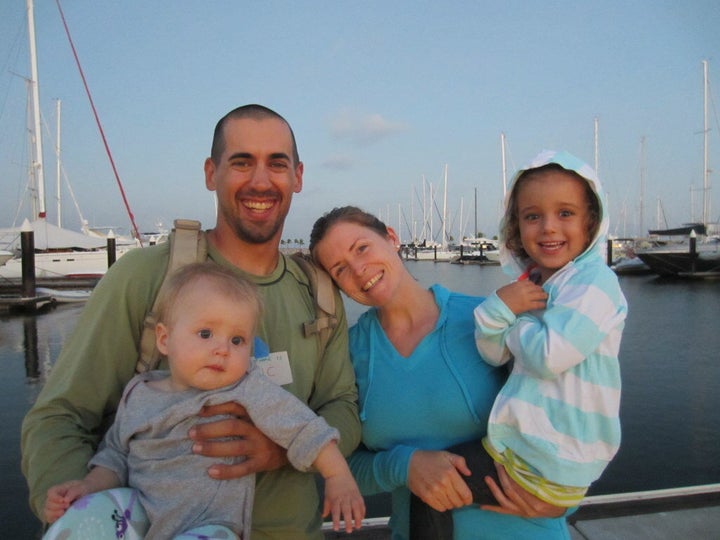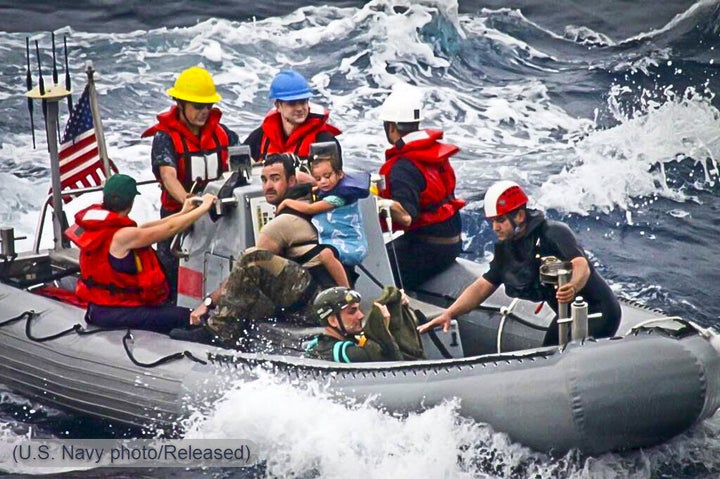
When we hit the emergency beacon on our sailboat to get our 13-month-old the medical attention she needed, I fully believed I was a good parent who was making the right choice. A lot of people disagreed.
It was only our second date when my husband told me he wanted to sail around the world. As a lifelong traveler, I jumped at the chance to join him. Ten months into dating, we bought our sailboat together, a 36-foot Hans Christian cutter-rigged sloop, and named her Rebel Heart. Hans Christians are called “bluewater” boats because they are designed to cross oceans. We set about making sure we would be as ready as our vessel to sail across oceans too.
Eighteen months after buying her, we moved aboard full time, both to get used to living on a boat before we set sail, and to reduce our expenses and increase our savings for the trip.
In between dating, marriage and living aboard, my husband, a lifelong sailor, became a U.S. Coast Guard-licensed captain. I obtained my basic keelboat certification and we spent much of our nonworking time sailing the coasts of Southern California and the Channel Islands.
In 2010, we brought our first daughter home to live aboard and took her sailing for the first time when she was 3 months old, my husband solo-sailing while I breastfed her in the cockpit. My husband and I studiously researched and put best practices in place for sailing and cruising with kids aboard, including maintaining and knowing how to use an adult and pediatric medical kit onboard, running jacklines for child harnesses, teaching our kids to incorporate life jackets as part of their everyday cruising attire, and researching seating safety for children while underway.
After my oldest daughter’s birth, I sought out and befriended other cruising families, hoping to find a community of like-minded free-range parents on the water. In December 2011, I created an online group called Women Who Sail. The first seven members were all women who had kids and lived aboard and sailed like we did. Each woman began to invite more sailing women. Women Who Sail is now the largest online group of female sailors in the world, with almost 16,500 members in the main group and another 23,000 in the regional and topical subgroups.
In 2013, eight years after buying our boat, we sailed from San Diego to Mexico. Our oldest was 2 and I was seven-months pregnant with our second child. She was born in Puerto Vallarta. Her first sail was at seven weeks old when we sailed up Mexico’s Pacific coast and then across the Sea of Cortez to La Paz.
That year, in the Women Who Sail community in Mexico, five other children were born and brought home to live and sail on their families’ boats. And just like in communities of women all over the world, we buoyed each other up. Via VHF radio net we talked boat to boat about supporting newly postpartum mothers and scheduled meal trains that were delivered by both dinghy and walking down long docks to our sister sailors’ vessels. Sailing mom friends stopped by to take older kids for walks into town so the new mothers could rest with their babies. Older children easily interacted with the younger children, including all the kids on the docks in their activities.
By the time my oldest was three, she could motor our dinghy from shore to our anchored vessel with my husband pointing out her path to guide the way. She nimbled up the boarding ladder while wearing her life jacket and she understood the boat rules (underway she was never allowed in the cockpit or side decks without an adult present). We bathed her and her baby sister with a solar shower we rigged from the boom. Our life aboard was one filled with friendship, community, simplicity and immense amounts of quality time and togetherness.

In March 2014, with our youngest now over a year old, we found ourselves at last, beginning the first leg of our planned circumnavigation around the world as a family. We pointed our boat southwest from our departure port and toward the fabled islands of the South Pacific. Our children were 3.5 years and 13 months old. During the same departure window of our crossing, three other vessels sailed from Mexico to the South Pacific with infants younger than our 13-month-old. All made it to their ports of harbor without incident.
A week into our crossing, however, our youngest daughter got sick. After several days, when she was getting worse instead of better, our onshore doctor advised us to begin antibiotics. We started her on the medication but she was not responding. Then each of the redundancies we carried aboard for onshore communication, including VHF and SSB radios and our satellite phone, failed. The Emergency Position Indicating Radio Beacon (EPIRB) was our last method of communicating with land, and as the name indicates, was only to be used for emergencies. This was an emergency.
Pressing the EPIRB meant our family could get our daughter medical assistance ashore, but we also could not leave a vessel unmanned. This would render it a navigational hazard. We knew that calling for help would mean we would have to scuttle the boat, the nautical term for sinking her. We did what any good parent would do and chose our kid over our vessel, which had been our family’s home for seven years, and we would make that same choice again if we had to.
We hit the EPIRB and were rescued by four U.S. Coast Guard pararescuemen. They stabilized our daughter until a larger vessel arrived to take us to shore. When we arrived at port our daughter received immediate medical care. Our doctor diagnosed a reoccurrence of Salmonella typhi (typhoid fever), a condition both she and I had contracted and recovered from before departing for the South Pacific.

After our rescue and return to San Diego, we faced a firestorm of criticism about our parenting. Our story was everywhere and our lifestyle and parenting choices were widely decried and debated in print and on social media. The New York Times, one of many newspapers reporting on our story, published “2 Tots, a Sailboat and a Storm Over Parenting.” Salon.com published the piece, “Don’t Judge the Sailboat Rescue Parents.” Comments on our rescue openly called for our children to be taken away and included people wishing that all four of us had drowned.
All of this was brought back to the forefront when I read Caroline Van Hemert’s recent article in The New York Times, “Sailing in Treacherous Waters to Alaska. With Toddlers for a Crew,” in which Van Hemert describes sailing Alaska’s Inside Passage with her 2- and 4-year-old sons.
The comments section on her piece is a tiny microcosm of the type of criticism we faced upon our return. But overall, the comments on Van Hemert’s piece include far more support than we received, and I believe that is because nothing untoward happened to her family as they sailed. If we had successfully arrived in the Marquesas, the only headlines about us would have been ones that highlighted our unique lifestyle, or feature stories like Van Hemert’s, showing the world that people can live differently than the way most of us are used to.
Almost everyone loves daring, dauntless people, right up until the moment that something goes wrong. The narrative is flipped then, when adventurers run into trouble and descriptors shift from “daring and dauntless” to “selfish, reckless and full of hubris.” Instead of praise for those marching to the beat of their own drum, there is condemnation, and the curiosity and interest pieces on these lifestyles switch to derision.
This type of parent-shaming is not reserved for adventurers alone. In fact, modern parenting is a lose-lose scenario, where families who choose to raise children in the supposed safety of suburbia face criticism for overprotecting their offspring, and parents like Van Hemert and myself are accused of reckless endangerment. Our culture has decided to judge parents no matter what.
My husband and I are not bad parents, and I am not here to apologize. We also aren’t “good parents who made a bad choice” by sailing with our kids. Like Van Hemert and most sailing families, we were and are deeply engaged in our parenting. We were well-prepared and experienced sailors, who had a vessel full of redundancies, and when a cascading series of events took out all of our options save one, that fail-safe worked.
The events that happened to us at sea rarely ever happen. When “This American Life” detailed our rescue in Episode 525, “Call for Help,” they confirmed with the American Boat and Yacht Council that there are hundreds of families sailing with children and that the type of sailing that my family and Van Hemert’s family does is “routine.” On the adventurous side of routine, but indeed routine.
After our rescue, members of the sailing community and Women Who Sail were our most vociferous supporters, starting the now much-beloved hashtag among sailors, #KidsOnBoats.
I am calling for an end to the sanctimonious handwringing about children’s safety when it comes to lifestyles different than our own. Enough with the false proclamations that mainstream American life is the default and safest option for raising families.
If we are truly concerned about keeping our kids safe, let’s really talk about what is putting our children at risk. Last year, more American children died in school shootings than service members died while deployed. The biggest killers of kids in our country are car crashes and gun fatalities. There is an epidemic of children with Type 2 diabetes, and let’s look squarely at the kids in poverty in this country who daily face hunger and homelessness.
After we lost our boat, we struggled for several years trying to raise children in San Diego. We were surrounded by families and a culture that subscribed to the methodology of helicopter parenting, which felt antithetical to our more free-range sensibilities. Moms hovered within arm’s reach of their kids at the sanitized playgrounds throughout the city. We yearned for a lifestyle that more closely resembled the freedom and ethos of sailing, and so we looked to the Eastern Sierra.
Our town is small. Families know each other. Children race around the trails that weave in and out of the city’s edge and ride their bikes and scooters unaccompanied by adults. My now 8- and 6-year-old daughters walk by themselves from school to the local library and it’s common practice to see children roaming our streets in packs without a single adult in sight.
The biggest dangers my kids face living in this mountainous world are not the black bears or mule deer we encounter around town ― our children are far more likely to be hurt by the trappings of modern living that we cannot escape, even here. There’s our neighbor who won’t stop speeding on our dead-end street, and the threat of school shootings is just as real in our idyllic city as it is all across America.
Threats to children’s safety exist in any lifestyle that parents choose, and there are ways to mitigate those threats, be prepared, live responsibly and teach our kids to do so as well. Why not stop the parent-shaming and focus on supporting families instead? Let the parents who want the familiarity of the mainstream raise their children as they will, and let parents with rebel hearts seek the path of a life lived outside of the box.
Do you have a compelling personal story you’d like to see published on HuffPost? Find out what we’re looking for here and send us a pitch!
